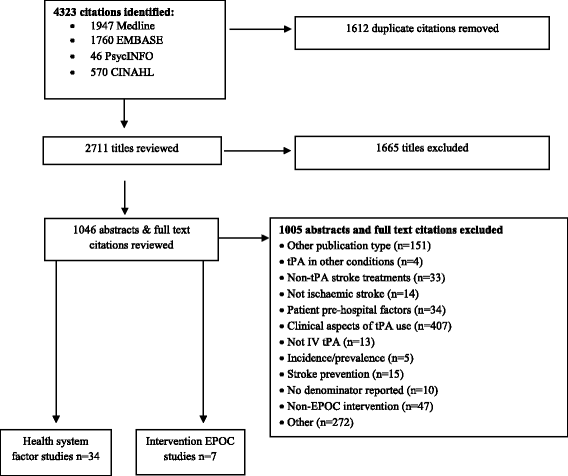How can we improve stroke thrombolysis rates? A review of health system factors and approaches associated with thrombolysis administration rates in acute stroke care
- PMID: 27059183
- PMCID: PMC4825073
- DOI: 10.1186/s13012-016-0414-6
How can we improve stroke thrombolysis rates? A review of health system factors and approaches associated with thrombolysis administration rates in acute stroke care
Abstract
Background: Thrombolysis using intravenous (IV) tissue plasminogen activator (tPA) is one of few evidence-based acute stroke treatments, yet achieving high rates of IV tPA delivery has been problematic. The 4.5-h treatment window, the complexity of determining eligibility criteria and the availability of expertise and required resources may impact on treatment rates, with barriers encountered at the levels of the individual clinician, the social context and the health system itself. The review aimed to describe health system factors associated with higher rates of IV tPA administration for ischemic stroke and to identify whether system-focussed interventions increased tPA rates for ischemic stroke.
Methods: Published original English-language research from four electronic databases spanning 1997-2014 was examined. Observational studies of the association between health system factors and tPA rates were described separately from studies of system-focussed intervention strategies aiming to increase tPA rates. Where study outcomes were sufficiently similar, a pooled meta-analysis of outcomes was conducted.
Results: Forty-one articles met the inclusion criteria: 7 were methodologically rigorous interventions that met the Cochrane Collaboration Evidence for Practice and Organization of Care (EPOC) study design guidelines and 34 described observed associations between health system factors and rates of IV tPA. System-related factors generally associated with higher IV tPA rates were as follows: urban location, centralised or hub and spoke models, treatment by a neurologist/stroke nurse, in a neurology department/stroke unit or teaching hospital, being admitted by ambulance or mobile team and stroke-specific protocols. Results of the intervention studies suggest that telemedicine approaches did not consistently increase IV tPA rates. Quality improvement strategies appear able to provide modest increases in stroke thrombolysis (pooled odds ratio = 2.1, p = 0.05).
Conclusions: In order to improve IV tPA rates in acute stroke care, specific health system factors need to be targeted. Multi-component quality improvement approaches can improve IV tPA rates for stroke, although more thoughtfully designed and well-reported trials are required to safely increase rates of IV tPA to eligible stroke patients.
Keywords: Health system change; Implementation; Ischemic stroke; Quality improvement; Thrombolysis; Tissue plasminogen activator.
Similar articles
-
Intravenously administered tissue plasminogen activator useful in milder strokes? A meta-analysis.J Stroke Cerebrovasc Dis. 2014 Sep;23(8):2156-2162. doi: 10.1016/j.jstrokecerebrovasdis.2014.04.008. Epub 2014 Aug 10. J Stroke Cerebrovasc Dis. 2014. PMID: 25113080
-
Optimizing the management of acute ischaemic stroke: a review of the utilization of intravenous recombinant tissue plasminogen activator (tPA).J Clin Pharm Ther. 2012 Dec;37(6):620-9. doi: 10.1111/j.1365-2710.2012.01366.x. Epub 2012 Jun 19. J Clin Pharm Ther. 2012. PMID: 22708668 Review.
-
Current status of intravenous thrombolysis for acute ischemic stroke in Asia.Int J Stroke. 2011 Dec;6(6):523-30. doi: 10.1111/j.1747-4949.2011.00671.x. Int J Stroke. 2011. PMID: 22111797 Review.
-
ICU Interventions in Ischemic Stroke Patients Treated Using Liberalized IV-tPA Criteria.J Stroke Cerebrovasc Dis. 2019 Sep;28(9):2488-2495. doi: 10.1016/j.jstrokecerebrovasdis.2019.06.015. Epub 2019 Jul 3. J Stroke Cerebrovasc Dis. 2019. PMID: 31277995
-
A systematic review and meta-analysis of interventions to increase stroke thrombolysis.BMC Neurol. 2019 May 3;19(1):86. doi: 10.1186/s12883-019-1298-2. BMC Neurol. 2019. PMID: 31053101 Free PMC article.
Cited by
-
Study the effect of static magnetic field intensity on drug delivery by magnetic nanoparticles.Sci Rep. 2021 Sep 10;11(1):18056. doi: 10.1038/s41598-021-97499-7. Sci Rep. 2021. Retraction in: Sci Rep. 2022 Aug 16;12(1):13838. doi: 10.1038/s41598-022-18378-3. PMID: 34508159 Free PMC article. Retracted.
-
Stroke onset to needle delay: Where these golden hours are lost? An Egyptian center experience.eNeurologicalSci. 2019 Jan 8;14:68-71. doi: 10.1016/j.ensci.2019.01.003. eCollection 2019 Mar. eNeurologicalSci. 2019. PMID: 30671551 Free PMC article.
-
The impact of a comprehensive national policy on improving acute stroke patient care in Lithuania.Eur Stroke J. 2022 Jun;7(2):134-142. doi: 10.1177/23969873221089158. Epub 2022 Apr 7. Eur Stroke J. 2022. PMID: 35647307 Free PMC article.
-
Integrative Approaches in Acute Ischemic Stroke: From Symptom Recognition to Future Innovations.Biomedicines. 2023 Sep 23;11(10):2617. doi: 10.3390/biomedicines11102617. Biomedicines. 2023. PMID: 37892991 Free PMC article. Review.
-
Does the Addition of Non-Approved Inclusion and Exclusion Criteria for rtPA Impact Treatment Rates? Findings in Australia, the UK, and the USA.Interv Neurol. 2020 Feb;8(1):1-12. doi: 10.1159/000493020. Epub 2018 Sep 25. Interv Neurol. 2020. PMID: 32231690 Free PMC article.
References
-
- Lopez AD, Mathers CD, Ezatti M, Jamieson DT, Murray DJL. Global burden of disease and risk factors. New York/Washington: Oxford University Press and the World Bank; 2006.
-
- Mackay J, Mensah G. The atlas of heart disease and stroke. Geneva: WHO; 2004.
-
- Agency for Healthcare Research and Quality. Household component summary table. In: Medical Expenditure Panel Survey. U.S. Department of Health and Human Services. 2012. http://meps.ahrq.gov/mepsweb/. Accessed 12 Nov 2012.
-
- Australian Bureau of Statistics . Cardiovascular disease in Australia: a snapshot, 2004-05. Canberra: ABS; 2006.
-
- Australian Institute of Health and Welfare . Australia’s health 2006. Report. Canberra: AIHW; 2006.
Publication types
MeSH terms
Substances
LinkOut - more resources
Full Text Sources
Other Literature Sources
Medical
Miscellaneous


